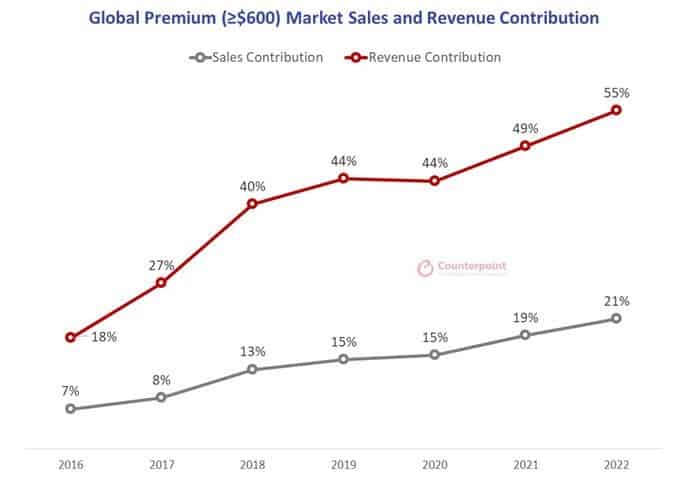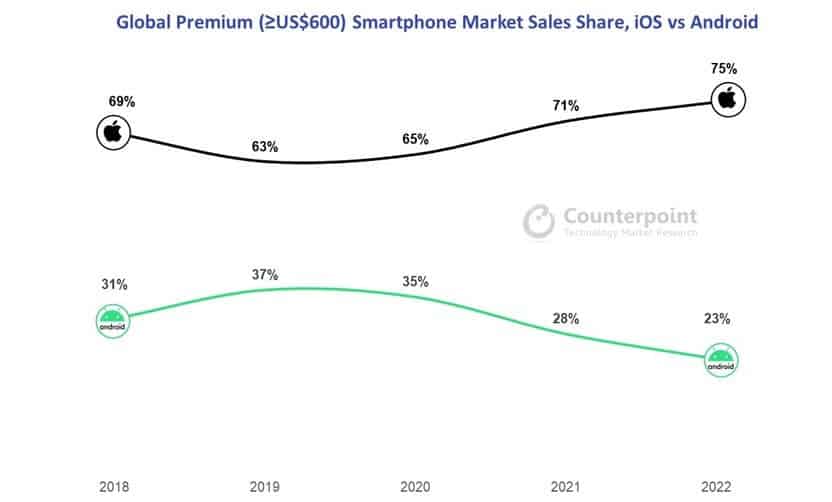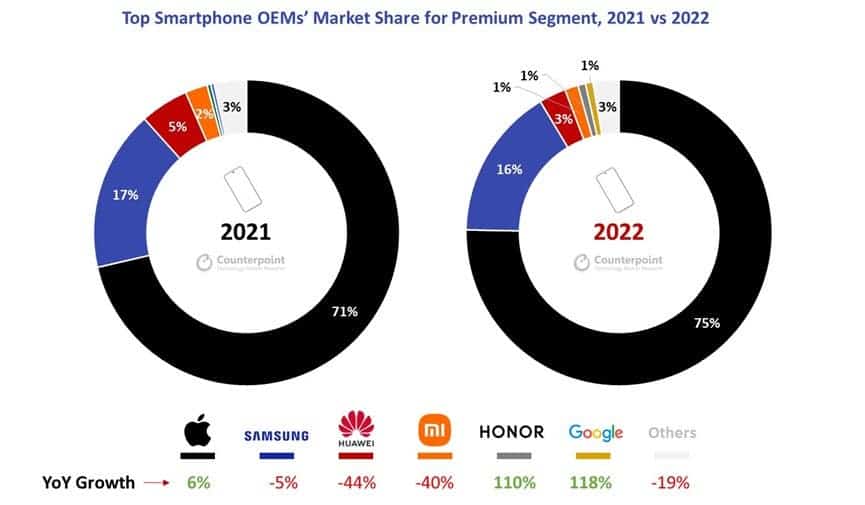In 2022, the global smartphone market faced macroeconomic difficulties that led to a 12% YoY decline in overall sales. However, there was a contrasting growth in the global premium smartphone market, which saw a 1% YoY increase in sales. This growth has allowed the premium price segment to contribute to 55% of the total global smartphone market revenue for the first time ever. Additionally, the premium segment captured more than one-fifth of total global smartphone sales.
Apple iPhone captures 75% of the premium smartphone market in 2022

According to CounterPoint Research, several factors contributed to the growth of the premium smartphone market in 2022. One of the main factors was the resilience of affluent consumers, who were less affected by macroeconomic difficulties compared to other customers. As a result, sales in the premium market grew, while those in the entry and mid-tier segments declined. Furthermore, as smartphones become more central to people’s lives, they are willing to spend more on their devices and retain them for a longer period. This is evident in the fact that the $1,000 and above price segment was the fastest growing, with a 38% YoY increase in sales.

Another key factor for growth was the “premiumization” trend across regions. Demand in the premium segment was driven by people upgrading their last device. The upgrades were evident not only in mature markets like North America but also in emerging economies where consumers on their third or fourth device started to break into the premium market.
Among OEMs, Apple saw a 6% YoY increase in sales in the premium market, expanding its share to capture three-fourths of the total sales in the segment. However, Apple could have grown more if not for the iPhone 14 Pro and Pro Max supply disruption during the peak holiday season in 2022. Apple also gained from Huawei’s decline in China.
Gizchina News of the week
Samsung ranks second in the premium smartphone market

Samsung, on the other hand, saw a decline of 5% YoY in 2022. The company lost out on the China market opportunity due to its weak presence in the region. Additionally, the launch of the Galaxy S22 series in 2022 took place much later than that of the S21 in 2021. However, the growth of foldable smartphones has been a bright spot for Samsung.
Honor gained from a low base as it expanded its market share in China driven by the Magic series. The brand will make a global push in 2023. Google was also featured among the top OEMs growing from a low base. Driven by the Pixel 6 Pro and Pixel 7 Pro. Google has increased its focus on the smartphone segment. Apart from these, most Chinese OEMs declined in 2022 due to difficult operating conditions in the domestic market, from where they derive a significant portion of their flagship sales.
For Apple, the growth in mature markets came from the upgrades in its installed base. The stickiness of the iOS ecosystem with multiple devices and services is high. If an iPhone user also owns an Apple Watch or Mac, the individual’s next smartphone upgrade will likely be another iPhone. Additionally, because of Apple’s aspirational brand value and step-by-step expansion, its sales have been growing in emerging economies as well. Android’s loss of share to iOS in the premium segment is also one of the reasons for Google’s smartphone push.
However, Android could see a new wave of growth in 2023 as more OEMs are expected to launch foldable devices in the premium segment this year. Existing foldable offerings in China are set to expand to markets outside the country. We will also see Honor pushing into the European market to gain a share this year.
In conclusion, the growth of the premium smartphone market in 2022 was driven by several factors. Including the resilience of affluent consumers, the premiumization trend across regions, and the stickiness of the iOS ecosystem. Apple was the top performer in the premium segment, followed by Samsung, HONOR, and Google. In 2023, we expect to see more OEMs launching foldable devices in the premium segment. Which could lead to a new wave of growth for Android. Additionally, Honor’s expansion into the European market could further shake up the premium smartphone market.





